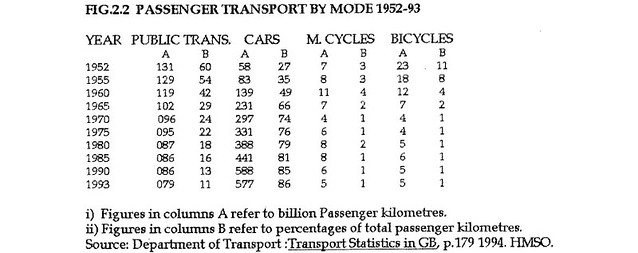
«We are nourishing a monster of great potential destructiveness.» Colin Buchanan, 1960. Quote referring to the car-oriented planning in a report for the Minister for Transport, UK. It was a privilege to read, over the last few days, a thesis written by Joe Goddard - a friend of Mikael’s. The thesis’ full title is “Cycle Paths and City Traffic 1945-1995” and it was a work submitted to the University of Bristol, in order to obtain the Master of Arts degree in the Faculty of Historical Studies. Amazingly, it was written back in 1995. Back then there were hardly any papers about bicycle infrastructure or bicycles at all so Mr Goddard was quite ahead of the modern curve.
Dr Joe Goddard is now Associate Professor of American Studies at the University of Copenhagen. His most recent book is also fascinating:
Being American on the Edge - Penurbia and the Metropolitan Mind, 1945-2010
Three countries are analysed regarding their cycling policies from 1945 to 1995: Britain, Germany and Denmark. It is important to mention that, in this fifty year period, there were several stages involved. One detail stands out immediately after reading Goddard’s work: all countries started with similar approaches to cycling. The interesting fact, however, is that they now have totally different levels of cycling. In the author’s opinion, that happened due to four different factors throughout this 50 year period analysis:- Government policies;
- Social factors;
- Industrial complex;
- Influence of national cycling groups.
Before 1945 In all three countries the first cycle tracks were created before the war (see table below). The levels of cycling were high in that period and remained somewhat the same until late 60’s or 70’s (when the car “boom” happened). The author also refers that Denmark had a late industrialization when comparing to the other countries, and also high density agglomerations, which may be one of the causes for the cycling levels then and afterwards.
UK Transport Advisory Council Report - 1930s
After 1945 to late 50’s Right after the war, the bicycle and public transport dominated urban traffic in Denmark. The country was not as destroyed by the war as several other countries were, which deeply influenced urban planning. Moreover, since the 40’s, at least, that Denmark has the same cultural preference for bicycles and a continued proactive investment in cycling infrastructures, regardless of changes in governments. In a few words, the country was coherent when it comes to cycling and cycling policies. Curiosity: in this period, it wasn't the car that threatened levels of cycling in Denmark: it was the number of mopeds.
Colin Buchanan, 1960 The cycling levels in Germany had “boomed” on this post-war period.
Social movements were influential in this period: Britain had The National Cycling Charity (CTC) and Denmark had the Danish Cyklistforbundet (DCF); on the other hand, at the time Germany had no significant cycling lobbyists.
Late 50’s to mid 70’s In all three countries this was the car era. Cycling levels were very low and most planning models were based on the American one, due to the fact that it was associated with progress.
Figures for UK
In Germany, the cycling policies were planned at a municipality level and the national government only provided guidelines. Until the late 70’s, the government had a very low activity when it came to cycling policies. Furthermore, with all the destruction caused by the war and subsequent rebuilding, the planning model shifted to a supposed more modern one: the American model. This meant that commutes covered longer distances, which started being covered by using a car. Cycling planning had a strong influence of motorisation, which meant that cars had the priority. The American model influence was so deep that some planners even mentioned that «it would be better if cycling didn't exist» (pg. 35).
From the 70’s to 1995
UK: Transport Policy - A Consultation Document - 1976 In Britain, the discussion of segregation versus integration is seen by the author as an influence on low cycling levels. Also, most cycling schemes are «localised, and commercially financed rather than socially inspired.»
Figures for UK In Germany, the counter-culture started to rise as a social factor that influenced cycling lobbyism. It is very important to mention that Germany is a very particular case: the influence of the car industry and manufacturers on the whole economy was outstanding – it probably still is. Nonetheless, cycling levels are greater than in Britain, where the car industry doesn’t have as much influence as in Germany. The author refers to the fact that cyclist lobbying levels may differ, hence the amount of influence. The social factor in Germany started to be very important in this period: cycling was seen firstly as a counter-culture. All four factors mentioned previously had a direct influence on cycling levels. Throughout the different periods after the war, these four factors oscillated, in some cases more than others. On a final and personal note, while reading the work, it was possible to understand that some mistakes that were done by these three countries are still being done all over the globe. However, the relevance of social movements is demonstrated in Goddard’s as being so strong that they could – and did – influence government policies on cycling. - Interesting facts:
| Facts | Britain | Denmark | Germany |
| First cycle track (year) | 1937 | 1905 (now regarded as 1892) | 1897 |
| Segregation or integration of cycle tracks | Integration | Segregation | ‘Radweg’ – Shared pavement between cyclists and pedestrians |
| Most evident cyclists movement | CTC | DCF | The People |
Cycle_Paths_City_Traffic_1945-1995_Joe_Goddard.pdf
Please cite Joe Goddard, of course, but also Copenhagenize if you write about it or quote from it.









